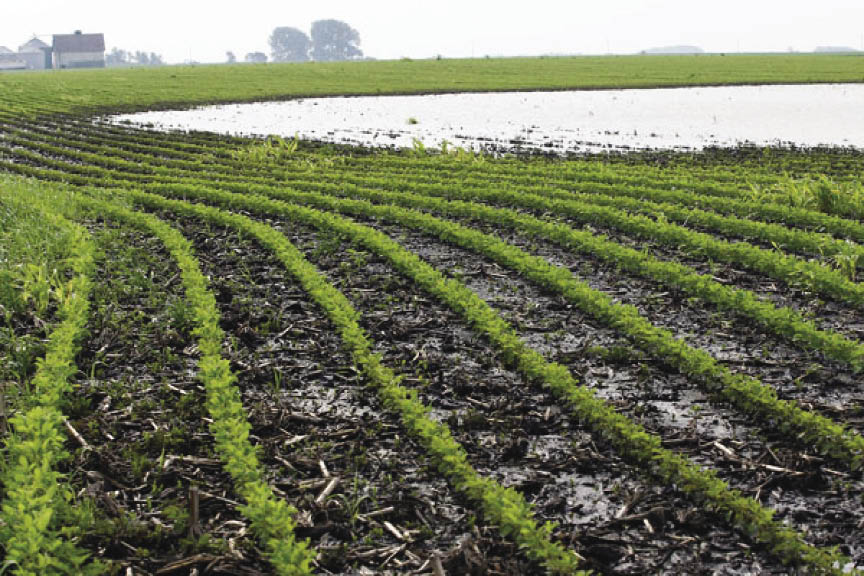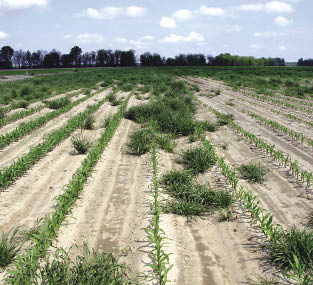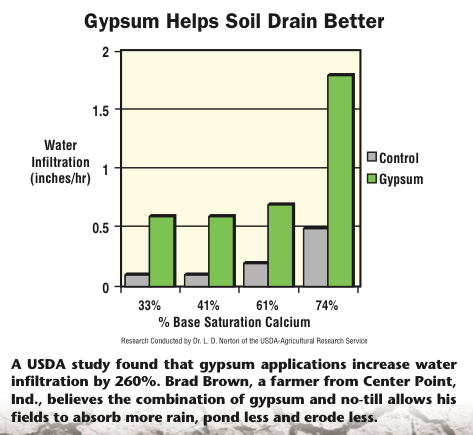When discussing weather, water is often the main topic. In the upcoming volatile years, the question is how to deal with both too much and too little water.
Crop water demand may even be increasing with or without drought.
“A few trends are really clear. There is increased frequency of high temperature stress, more rain in heavy rainfall events across the U.S. — ironically with more summer droughts. Because growing seasons are longer with higher summer temperatures more water is needed,” says David Wolfe, Cornell professor of plant and soil ecology.
The trend of planting longer season varieties results in more transpirational water loss in crops, he says.
“Even if the rainfall stays the same, there may not be enough to meet crop demand in the Northeast if crop water demands go up,” he says.
Catch Every Possible Drop
Farmers need to ask themselves how they’re going to manage the soil resource to make sure every drop of rainfall can be put back into the crop, says Hatfield of the National Lab for Ag and the Environment.
“One of the major things we can do to protect ourselves against heavy rains in the spring is to go to more conservation tillage so you have residue on the surface to protect the soil from erosion,” he says. “Building soil organic matter also increases soil water holding capacity.”
Of the 313 farmers surveyed by No-Till Farmer, 64.5% say they are switching to no-till or minimum tillage for moisture conservation. When asked if changes in management strategies resulted in the purchase of new or used equipment, multiple farmers noted the purchase of no-till or other conservation tillage equipment.
In addition to conservation tillage, cover crops build even more residue, improve soil structure and reduce soil water evaporation.
“If water in the profile isn’t evaporating, it will be used by the crop,” Hatfield says.
Cover crops are an ideal partner for strip-tillage, he adds. Fertilizer and seed can be placed in the tilled area while cover crops protect the soil and capture nitrogen that can be released back to the crop during the growing season.
Farmers aren’t the only ones that need strategies to cope with volatile weather patterns. Seed companies are carefully watching weather patterns and developing traits and hybrids to make the most of available water.
“There is a challenge in how weather patterns change from year to year in how quickly we can respond with breeding and traits to develop variations,” says DuPont Pioneer’s Mark Cooper, who oversees trait characterization and development.
Advances in molecular technology that allow improved prediction of expected performance help along with the ability to do field tests in northern and southern hemispheres for two cycles of testing in one year. Another challenge is they have to develop a plant that will give stability across a range of environments, water limitations and temperatures.
“It’s not unlike the Olympics. A hybrid may be a specialist, great in one area, but not the best at other events,” Cooper explains.
“It’s our job to find and build hybrids that have good performance under a wide variety of conditions.”
Optimum Aquamax hybrids were developed and initially targeted to the northern and western reaches of the Corn Belt to help make the most of available moisture. However, it will be bred and marketed in the central Corn Belt eventually, too.
Cooper sees this hybrid having a fit for evening up production in fields with soils that have variable water holding capacities.
Don’t Waste Water
When faced with high rainfall events, many producers will be tempted to consider investing in drainage. Hatfield cautions against getting too carried away with installing subsurface draining to channel away spring moisture.
“Once water is in the drain it’s down the river and no longer available in the soil,” he says. Many of those who got early rains in 2012 were wishing they had more of that moisture around later in the season.
Brown, the farmer from Indiana, did have more moisture thanks to no-till and soil-structure building applications of FGD gypsum. He claims the combination of gypsum and no-till allows his fields to absorb more rain, pond less and erode less. Soils also stay moist, crops root better and temperature in his field is moderated.
“Even with the drought this year our fields are dry, but not bone dry. There’s some moisture in the soil,” Brown says. “The soil in our neighbors’ fields, however, is dusty dry.”
A USDA study found that gypsum applications increase water infiltration by 260%.
Brown is expecting to harvest a 100-bushel corn crop when crop adjusters are predicting just 45-65 bushels in nearby fields.

“One of the major things we can do to protect against heavy rains in the spring is to go to more conservation tillage so you have residue on the surface to protect the soil from erosion,” says David Wolfe of Cornell Univ.
Photo courtesy of Purdue Agricultural Communication
Some farmers lean on tillage to dry out fields in the spring, but Hatfield warns against it.
“More tillage makes the soil more susceptible to runoff so it increases erosion,” Hatfield says. “We have to get aggressive at reducing tillage and managing the soil to be able to absorb, hold and make water available back to the crop.”
Nitrogen Tightrope
Too much water and nitrogen is at risk of leaching through the soil profile or running off the top. Too little moisture and nitrogen can’t do its job. That’s why managing this expensive input will be a tightrope walk in the upcoming volatile weather years.
According to Fred Below, Univ. of Illinois professor of plant physiology, and his “Seven Wonders of the Corn Yield World,” nitrogen is second only to weather in yield impact, contributing to 70 bushels of yield potential. While it may be tough to manage in upcoming years, the reward is worth the effort.
“I believe we’ll see more sidedressing of nitrogen to put nutrients on when the plant needs it. Or, if we have dry conditions like this year, not applying nitrogen because there’s no water so the plants can’t use it,” Hatfield says.
Split nitrogen applications is a trend Jeff Whetstine, vice president of global marketing for Koch Agronomic Services, has already seen producers leaning on to get nitrogen to the plant while minimizing weather risk.
“Using split applications not only manages weather risk, but manages the amount of time spent in the field at critical times, such as planting. Weather windows are closing down on us, so people are now open to not putting all the fertilizer down at once,” he says.
Even with a split application, though, there is a need for speed in application.
“With dry box spreaders such as those made by New Leader, producers can spread nitrogen in-season at speeds up 15-20 mph vs. 6-8 mph with a toolbar,” he says.
This is an option even in no-till with nitrogen stabilizing technologies such as Agrotain.
“Without a nitrogen stabilizer, urea spread on the surface can see 30% volatilization loss with much of that occurring in the first several days,” Whetstine says. “When protected by Agrotain, that nitrogen can wait for a rain for about two weeks.”
The longer the nitrogen is stable, the more chances there are to get rain into the soil profile. Those growers that choose to knife in nitrogen can prevent losses into the air but are at risk of leaching losses during wet weather. Leaching losses occur after biological activity converts nitrogen into the nitrate form.
“We want nitrogen to be available to plants when needed. With an Agrotain Plus stabilizer product we’re able to keep it in an ammonium form longer so that is not prone to loss for 6-8 weeks after application,” he says.
Tread Lightly
Compaction can be an issue with drought and rain. Equipment and strategies that minimize compaction must be top of mind for farmers.
“Once moisture leaves the soil it collapses and gets tighter and tighter and that compaction goes deeper and deeper,” says Joe Dedman, vice president of agronomy, Monty’s Plant and Soil Products.
There is a whole gamut of tools that can help loosen the soil again. Dedman notes the benefits of ripper or vertical tillage tools that don’t necessarily heave soil up, but shatter it in a way that soil structure and texture come apart and work better.
“There is a role for vertical tillage depending on how deep we go,” Hatfield says. “Producers may want to start with vertical tillage to remove a compaction layer, but not do it every year once they get soil management practices headed down the path of soil improvement.”
No-till, cover crops and various soil amendments are also known soil structure builders. Dedman adds the possibility of humic-based soil conditioners.
“Testing over the last four years has shown when we put the soil conditioner product in the row on the seed there is early root expansion and establishment that gives season-long benefits,” he says.
Putting on the soil conditioner often requires modifying equipment to get the product in the row on the seed. Dedman’s company runs a rebate program with dealers and farmers to help offset equipment modification costs.
For those that don’t want to fix compaction, the should avoid it.
“Spring is key. You have to get the soil prepped and the crop in the ground in good shape with the least amount of compaction,” says Phil Jennings, Kinze Manufacturing’s service manager. “The weight transfer hydraulic system on twinline planters helps spread out its weight — especially with bulk fill planters.”
In-Season Solutions
If increased farm size, timely weed control and fungicides weren’t enough reasons for producers to invest in their own sprayer, there may be a few more reasons on the table with variable weather. A number of foliar products on the market — ranging from plant foods to growth hormones — claim to be able to help plants overcome weather-related stress. And there is likely to be plenty of stress if the weather forecasters are right.
“In a year like this year, the soil dries up and no matter what fertilizer was thrown out in the field, it can’t work because it needs moisture and soil biology to convert it to plant food,” says Dedman. “But when true plant food products are utilized, as it hits the plant leaf it’s 100% available to the plant without moisture or soil biology.”
Strategic foliar feedings can help give plants longevity in tough conditions and make them able to respond quickly and revive to pull nutrients from the soil when rain does return, he says. It also can help manage heat stress.
Soybeans often bloom during the hottest part of the season, which can result in 60-70% flower abortion, Dedman says.
“If you come in with a plant food a week or two ahead of hot temperatures the soybeans will hold more blooms because they’re under less stress, increasing pods and giving more beans to increase yield potential,” he says. “Plant food also can be used in a timely manner to manage growth processes in a number of crops including corn, soybeans, alfalfa, tomatoes, almost anything.”
Similar benefits can be found in stress-mitigating plant hormone regulators like BioForge from StollerUSA.
“When a plant comes under stress it tends to go into retreat,” says Jeff Morgan, marketing director for StollerUSA. “It stops growing roots, stops moving sugars to the pods, seeds or ears and yield is lost. These products can be used to balance hormones to keep the plant growing roots and functioning properly even under stress.”
These products aren’t a cure-all in a year like 2012, but they have their benefits.
“We have reports from all over the Midwest of producers using these products. Their crops stayed greener longer, some set pods and ears and those growers will harvest,” he says. “It’s not an outstanding year, but they will get a return on their seed investment. It’s a way farmers can give themselves a little insurance policy.”
Products with stress-mitigating compounds can be applied at nearly any stage of growth when stress is likely to be a factor. There are seed treatments and in-row treatments that can be applied foliarly with almost any other field operation. This is a situation where producers would benefit from having their own sprayer, as applications are most beneficial directly before stress.
“You want to apply the products before stress because if you apply after stress, you will lose kernels or pods,” Morgan says. “You want to get in front of it.”
High Alert for Weeds and Pests
Winters are warming more than summers across the U.S., says Wolfe, the Cornell professor of plant and soil ecology. That is good news for those in more northern growing regions, such as Canada, that are seeing longer growing seasons that create growing opportunities. But, warming can bring problems.
“Warmer winters means more overwintering of pests including weeds and insects,” he says. “It’s always challenging to manage weeds and insects, but there will be even more challenges than usual because seeing new and different weeds and insects will be more common.”

Variable weather can make weed and insect control more challenging. “Growers took a beating this year with weed management,” says Matt Foster, FMC product manager.
Corn earworm, for example, has traditionally been a more of a pest in the south, but it has been showing up more and more in the Northeast, he says. Suitable habitat for kudzu is also moving north.
Variable weather can make weed and insect control more challenging, too.
“Growers are taking a beating this year with weed management,” says Matt Foster, FMC product manager. “We can’t just say use a pre-emerge product and all your problems will disappear. We need to communicate to growers that they need to look at their entire weed management strategy, not just what herbicide they’re going to use.”
In 2012, the pre-emergence products touted for solving resistance problems didn’t work well because they needed rain to be activated. Dismissing them entirely isn’t an option, though, because resistance isn’t slowing, he says.
“Even if a grower wasn’t satisfied with their pre-emergence herbicide this year when herbicide performance was handcuffed, think of what happens if we get any rainfall and there isn’t protection in the field,” Foster says. “You really get caught behind the eight ball. And once resistant populations get out front, you’re done.”
In general, pre-emergence herbicides are good products and they work, he says. But most of these products have no significant post-emergence activity, so it’s imperative to start clean.
Burndown applications are critical, and may be hampered by the trend in recent years to go toward low volume applications.
“We need to get those volumes back up and use flat fan nozzles where possible to ensure adequate coverage. We also need to consider chemicals besides glyphosate for burndown. Use 2,4-D or Dicamba to make sure the field is clean,” he says.
Especially in areas that struggle with resistant weed populations, Foster recommends considering the use of overlapping residuals to effectively control resistant weeds.
“The biggest thing is not to give up on a herbicide component of a weed management program because it was a tough year,” he says. “Most of the time we do get rain, and when it rains, a pre-emergence product will work.”
Thanks to tough weeds, and weeds and pests moving outside of their normal zones, sprayers may find more homes than ever.
Add to that no-till and continued strong soybean prices — resulting in more intense management — should continue to encourage the trend of growers owning sprayers and applying their own products, Foster says.
One thing that is clear is that farmers will have to be flexible and stay on their toes to be efficient and effective in a future with variable weather.
“This is the first generation of farmers that can’t rely on historical weather records. They have to base their decisions on what happens year to year,” Wolfe says.







